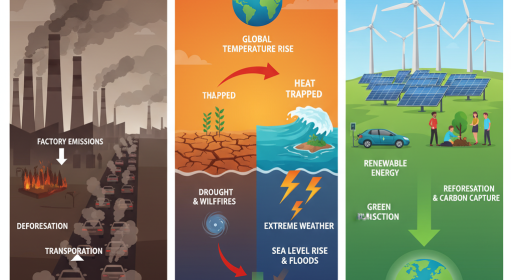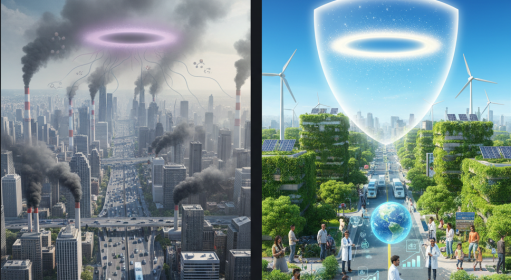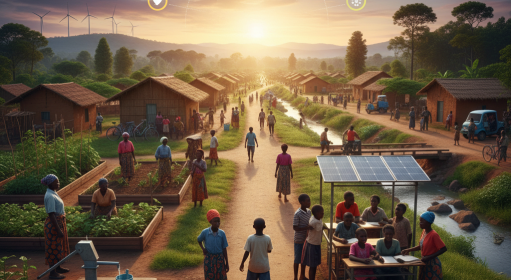High above Earth, in the stratosphere, lies a fragile shield: the ozone layer. This thin veil of gas absorbs harmful ultraviolet (UV-B) radiation from the sun, protecting humans, animals, and plants from excessive exposure that can cause skin cancer, cataracts, and crop damage. Without it, life as we know it would not thrive.
Yet, this natural shield is under stress. Since the mid-20th century, human activities (particularly the emission of chlorofluorocarbons (CFCs) and other ozone-depleting substances) have thinned the ozone layer. While global agreements like the Montreal Protocol (1987) have brought progress, urbanization, industrialization, and unsustainable consumption continue to pressure the atmosphere.
What is Ozone Layer Depletion?
Ozone depletion refers to the thinning of the ozone layer caused by both natural and anthropogenic (human-made) factors. The main culprits are chemicals such as:
- CFCs (chlorofluorocarbons) – once common in refrigerators, air conditioners, and aerosol sprays.
- Halons – used in fire extinguishers.
- Carbon tetrachloride and methyl chloroform – solvents and cleaning agents.
When these chemicals rise to the stratosphere, UV radiation breaks them down, releasing chlorine and bromine atoms. A single chlorine atom can destroy over 100,000 ozone molecules before it is deactivated. The result: ozone holes, such as the well-known seasonal thinning above Antarctica.
The Success of the Montreal Protocol
The Montreal Protocol, signed by 197 countries, is often called the most successful environmental treaty in history. It banned the production of most ozone-depleting substances. By 2019, the UN reported that the ozone layer was slowly healing, with full recovery projected by mid-21st century if compliance continues.
This shows that global cooperation works. However, new challenges (including illegal CFC production, rapid urbanization, and climate change interactions) threaten to slow progress.
Anthropogenic Causes of Ozone Stress
Beyond classic CFCs, other human-driven activities worsen ozone stress:
- Urbanization and industrial growth: Factories, vehicles, and construction release nitrogen oxides (NOₓ) and volatile organic compounds (VOCs), which interact with sunlight to form ground-level ozone (smog). This doesn’t deplete the stratospheric ozone, but it damages air quality and health.
- Deforestation: Reduces natural carbon sinks and alters atmospheric chemistry.
- Transport emissions: Cars, planes, and shipping contribute to both greenhouse gases and chemical pollutants.
- Waste burning and poor disposal: Releases toxic chemicals, including banned or unregulated ozone-damaging substances.
The Effects of Urbanization on the Ozone Layer
Rapid urbanization, especially in developing countries, has unintended consequences:
- Urban Heat Islands (UHIs): Cities trap heat due to concrete and asphalt, increasing local atmospheric temperatures and intensifying photochemical smog.
- Air Pollution: Large cities like Delhi, Lagos, and Beijing face chronic air quality crises, which affect ozone balance and human health.
- Increased Energy Demand: Air conditioning and industrial cooling rely on refrigerants. While many CFCs are banned, newer hydrofluorocarbons (HFCs) (though less harmful to ozone) are potent greenhouse gases, fueling climate change.
- Poor Waste Management: Open burning of waste releases harmful compounds, indirectly contributing to ozone stress.
Health and Environmental Impacts of Ozone Depletion
When the ozone layer thins, more UV-B radiation reaches Earth. The impacts are severe:
- Human Health: Increased skin cancers, eye cataracts, and weakened immune systems.
- Ecosystems: Crop yields decline, marine phytoplankton die-offs occur, and food chains are disrupted.
- Materials: Plastics, paints, and fabrics degrade faster under intense UV.
Case Studies: Urbanization and Ozone Stress
- Delhi, India: High levels of NOₓ and VOCs, combined with sunlight, create photochemical smog that worsens respiratory illnesses.
- Lagos, Nigeria: Rapid population growth and poorly regulated waste burning contribute to toxic emissions.
- Jakarta, Indonesia: Urban sprawl and vehicle emissions intensify both smog and greenhouse gas concentrations.
These cities show the urgent need to balance urban growth with sustainability.
Solutions: Protecting the Ozone While Growing Sustainably
- Strengthen Global Treaties: Ensure compliance with the Montreal Protocol and the Kigali Amendment (2016), which targets HFCs.
- Sustainable Urban Planning: Green roofs, urban forests, and improved public transport reduce emissions and urban heat.
- Renewable Energy: Solar, wind, and hydro reduce dependence on fossil fuels.
- Cleaner Cooling Systems: Develop ozone-safe and climate-safe refrigerants.
5. Public Awareness: Encourage waste reduction, proper disposal of old appliances, and energy conservation.
“Urbanization doesn’t have to harm the ozone layer. Cities that adopt eco-friendly infrastructure, renewable energy, and clean transport systems can grow sustainably without worsening atmospheric problems. Imagine African megacities like Lagos or Nairobi powered by solar grids, Southeast Asian hubs like Jakarta adopting electric buses, and Latin American capitals planting urban forests. The technology exists; what’s needed is political will, international cooperation, and public engagement.“
The ozone layer is a global commons; no single nation owns it, but every nation depends on it. Its depletion teaches us two lessons:
- Human actions have global consequences.
- Global cooperation can solve environmental crises.
Urbanization is inevitable, but it must be guided by sustainable policies. Protecting the ozone layer while creating greener cities ensures a healthier planet for future generations.




